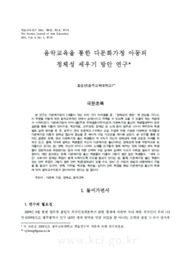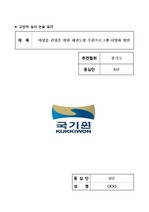

PARTNER
검증된 파트너 제휴사 자료
다문화가정 아동의 음악교육지도안 연구 (A study of the musical education for children from multicultural family - Focusing on Korean and Vietnamese music)
30 페이지
최초등록일 2025.06.04
최종저작일
2014.06

-
미리보기
서지정보
· 발행기관 : 한국국악교육학회
· 수록지 정보 : 국악교육 / 37권 / 37호 / 83 ~ 112페이지
· 저자명 : 안현정
초록
본 논문은 다문화가정의 문제점을 음악교육을 통하여 해결하는 것을 목적으로 두었고, 교육의 방법으로 베트남의 민요와 악기, 한국의 민요와 악기를 배움으로써 자연스럽게 두 나라의 문화적 차이점과 공통점을 익히게 하는데 목적을 두었다.
또한 지도방법으로 달크로즈와 코다이, 고든의 교수법을 활용하여 지도안의 다양성을 추구하여 연구 하였다. 교육대상은 다문화가정 중에서 베트남 다문화가정 초등학생 4~6학년을 대상으로 삼았으며, 한 학교에재학 중인 다문화가정 아동의 수를 생각하여 5인 이하의 소그룹으로 한정하여 음악수업지도안을 개발하였다.
연구방법은 3차시에 걸쳐 한국과 베트남의 민요와 선율악기인 양금과 단땀탑룩(Đàn tam thập lục), 타악기인 장구와 까이봉(Cái Bống)을 배우고, 듣고, 연주해 보면서 두 나라 음악의 차이점과 공통점을 알아보고, 배우고난 느낌을 몸과 손동작, 그림으로 표현해 봄으로써 음악을 배우는 과정의 스트레스를 줄이고 두 나라의 문화적 차이를 극복하고 익히도록 하였다. 또한 실험집단을 거친 연구가 아니므로 현재 재직 중인 초등 교사를 통해검증단계를 거쳤고 음악적인 형평성을 위하여 음악을 전공한 교사와 아닌 교사를 반씩으로 나누어 구성하였다.
다수의 나라에서 온 다문화 가정이 있지만 본 연구에서는 우리나라와 악기의 생김새와 재료, 소리의공통점이 많은 베트남으로 한정지었고, 민요와 선율악기 타악기도 두 종류로 제한하여 실제 수업에 가능한 활동들을 제시하는 지도안을 연구하였다.
1차시에는 한국과 베트남의 위치, 역사, 음악 등을 알아보고 한국의 민요와 베트남의 민요를 배우고익히게 하였는데, 진도아리랑과 Cây Trúc Xinh의 박자, 리듬, 장단, 가사를 설명하고 따라 부르게 하였다. 민요를 쉽고 효과적으로 익힐 수 있는 방법으로 진도아리랑은 달크로즈의 손기호를 활용하여 손으로표현하며 부르게 하였고, Cây Trúc Xinh는 코다이의 손 기호를 활용하여 손으로 표현하며 노래를 부르도록 하였다. 세마치장단인 진도아리랑과 굿거리장단으로 편곡한 Cây Trúc Xinh를 부르도록 하여 다음시간에 배울 장단도 듣고 익힐 수 있도록 하였다.
2차시에는 한국타악기인 장구와 베트남 타악기인 까이봉에 대해 소개하고 소리를 들려준 후 공통점과차이점을 논의해 보게 하였다. 우리나라 장단인 굿거리장단과 세마치장단을 장구와 까이봉으로 연주해보고, 달크로즈의 몸 표현 교수법을 활용하여 몸으로 표현하며 장단을 익히게 하였다.
3차시에는 한국악기 양금과 베트남악기 단땀탑룩으로 전 시간에 배운 민요를 장구와 까이봉으로 반주해주고, 반주에 맞춰 부르게 하여 각 나라의 전통음악을 연주하는 것을 들려주었다. 또한 그동안 배운 진도아리랑과 Cây Trúc Xinh의 가사를 고든의 교수법 오디에이션을 이용하여 그림으로 표현해보도록 하였다.
이 지도안을 현장에 적용 하였을 때의 기대되는 효과는 다음과 같다.
첫째, 서로 다른 부모의 나라를 동등한 시선에서 비교하고 관찰하여 보는 시간을 가져 문화적인 적대심이나 비하하는 시선을 교정하는 효과를 볼 수 있고, 다른 나라의 문화에 대한 이해와 학습의 흥미를유발 할 수 있다.
둘째, 다문화가정의 아동들이 겪는 문화적응 스트레스를 줄여주고, 신체나 악기로 자신의 감정을 표현하는 음악적 대화를 통한 만족감과 사회적 수용감을 느끼게 해준다. 또한 표현 활동을 통하여 음악으로심리적 치료의 효과를 기대할 수 있다.
셋째, 한국의 민요와 베트남의 민요를 각 나라의 악기로만 듣는 것이 아니고 한국의 악기로 베트남의민요를, 베트남 악기로 한국의 민요를 연주해 보면서 문화적인 동질감을 느끼고 각 나라의 음악의 가치를 배울 수 있다.
넷째, 다문화 음악교육을 통하여 다문화 가정의 아동들이 자신에 대한 올바른 정체성을 가지며, 더 나아가 다른 문화의 사람들에 대한 이해의 폭을 넓힐 수 있다.
다섯째, 서양의 음악교수법들을 활용하여 아동들의 음악적 창의성을 높이고, 음악을 표현하는 방법을다양하게 익히게 한다.
여섯째, 교사들의 설문검증을 거친 결과 충분한 시간배분을 통하면 다문화가정의 아동들을 지도하는데 알맞은 지도안이라는 피드백을 받았다.
이에 따라 본 연구는 다문화화 되어 가는 한국사회에서 다문화가정 아동의 문화적 소외감과 충돌을줄여주기 위한 지도법 활용에 도움이 되고자 하였다. 본고에서는 베트남으로 한정 지었지만 다문화 가정에 폭 넓게 쓰일 수 있기를 바라며 앞으로 다양한 교육방법이 개발되기를 바란다.영어초록
The aim of this study was to treat issues in multicultural family by musical educationin which Korean and Vietnamese folk songs and instruments were introduced and thuscultural similarities and differences between Korea and Vietnam were identified.
For achieving this aim, various methods of teaching were planned considering Dalcroze’s,Kodaly’s, and Gordon’s pedagogy. The target of the education was children in 4~6 gradesfrom multicultural family with Vietnamese background. Considering the number of childrenwho are from multicultural family in one school, the musical education fora group of 5or less children was developed.
During three classes, children would learn similarities and differences in Korean andVietnamese music by listening to and playing Korean and Vietnamese melody instruments(e.g., Yang Geum, Dan Tam Thap Luc) and percussion instruments (e.g., Jang Gu, CaiBong). Also, the stress associating with learning music would be reduced and the culturaldifference would be overcome by expressing the feeling of the instruments via gesturesand pictures. This study did not utilize the experimental research design, but was evaluatedby elementary school teachers, half of the teachers majored in music and another half ofthe teachers not major in music.
The musical education in this study focused on Vietnamese music since Vietnameseinstruments are similar to Korean in terms of design, material, and sounds. Also, forconvenience in the real education, the number of folk songs and instruments were limited.
Location, history, and music of Korea and Vietnam will be covered in the first class.
Then, children will learn and practice Korean and Vietnamese folk songs (e.g., Jindo Arirang, Cay Truc Sinh). To effectively learn the folk songs, Dalcroze’s and Kodaly’s signlanguages will be used to sing Jindo Arirang and Cay Truc Xinh, respectively. Childrenwill preview the contents of the next class by singing the folk songs with Semachi andGutguri rhythm.
In the second class, Korean and Vietnamese percussion instruments (e.g., Jang Gu, CaiBong) will be introduced and the similarities and differences between the instruments willbe discussed. The instruments will be played with Semachi and Gutguri rhythm, whichwill be expressed by gestures using Dalcroze’s bodily expression pedagogy.
In the third class, children will be guided to sing the folk songs (e.g., Jindo Arirang,Cay Truc Sinh) to the accompaniment of Korean and Vietnamese melody instruments (e.g.,Yang Geum, Dan Tam Thap Luc). It will be encouraged to express the lyrics of the folksongs by pictures utilizing audiation, Gordon’s pedagogy.
The following effects are expected from this musical education.
First, by having opportunities to experience different cultures of their parents, childrenfrom multicultural family would correct hostility and stigma toward the cultures andincrease understanding and interests in the cultures.
Second, it would reduce the stress related to the adaptation in different cultures and givechances to feel more socially accepted by expressing emotions via musical conversation.
Expressive activity would also have therapeutic effects.
Third, by playing Korean folk songs with Vietnamese instruments and vice versa,children from multicultural family would see cultural similarities between Korea andVietnam and experience cultural value in Korean and Vietnamese music.
Fourth, it would enhance the sense of identity and, furthermore, increase theunderstanding of people from different cultures.
Fifth, pedagogy from Western culture would help children from multicultural familydevelop musical creativity and teach ways to musically express emotions.
Sixth, based on the feedback from teachers, this musical education would be appropriateto guide children from multicultural family if sufficient time is allocated (for what? forteaching or for developing the education?)We expect that this study would be used to reduce isolation and cultural conflict in children from multicultural family in Korea. Although the target of the education waslimited in children with Vietnamese background in this study, the musical education couldbe modified and used for children with different background. It is expected that this studywould encourage developing more educational ways to help children from multiculturalfamily.참고자료
· 없음태그
-
자주묻는질문의 답변을 확인해 주세요

꼭 알아주세요
-
자료의 정보 및 내용의 진실성에 대하여 해피캠퍼스는 보증하지 않으며, 해당 정보 및 게시물 저작권과 기타 법적 책임은 자료 등록자에게 있습니다.
자료 및 게시물 내용의 불법적 이용, 무단 전재∙배포는 금지되어 있습니다.
저작권침해, 명예훼손 등 분쟁 요소 발견 시 고객센터의 저작권침해 신고센터를 이용해 주시기 바랍니다. -
해피캠퍼스는 구매자와 판매자 모두가 만족하는 서비스가 되도록 노력하고 있으며, 아래의 4가지 자료환불 조건을 꼭 확인해주시기 바랍니다.
파일오류 중복자료 저작권 없음 설명과 실제 내용 불일치 파일의 다운로드가 제대로 되지 않거나 파일형식에 맞는 프로그램으로 정상 작동하지 않는 경우 다른 자료와 70% 이상 내용이 일치하는 경우 (중복임을 확인할 수 있는 근거 필요함) 인터넷의 다른 사이트, 연구기관, 학교, 서적 등의 자료를 도용한 경우 자료의 설명과 실제 자료의 내용이 일치하지 않는 경우
“국악교육”의 다른 논문도 확인해 보세요!
-
판소리 음악 연구의 유형별 특징 분석 41 페이지
본고에서는 판소리 연구관련 논문들 중 음악학적인 측면을 중심으로 연구된 논문들을 살펴보았다. 최근 들어 판소리 음악연구의 중요성이 증대되고 있어서『한국음악연구』,『한국음악사학보』,『국악교육』,『국악교육연구』,『판소리 연구』등 여러 학회지에 많은 성과물들이 발표되고 있다. 판소리가 세계무형유산에 등재 되는 등 판소리에 관련된 중요성이 상당히 강조되고 있다. .. -
한국음악에 나타나는 동주음조(同主音調)에 관한 연구 26 페이지
음악에 대한 학문적 기반은 서양음악과 마찬가지로 한국음악에서도 삼분손익법에서 시작된다. 이후 각각의 특징적 변화 방법에 따라 얻어진 현재의 결과물은 서로 많은 차이점을 내포하고 있으나 근본적 초기과정에서는 거의 같다고 할 수 있다. 이러한 초기 과정에는 ‘동주음조’도 포함되나 한국음악에서는 ‘동주음조’라는 용어를 사용하지 않았을 뿐 실제로 음악에서 사용하고.. -
초등학교 국악교육에서의 말붙임새 창작활동 적용 연구 26 페이지
본 연구는 초등학교 국악교육에서의 말붙임새 창작활동의 지도방안을 설계하고, 이를 초등 4학년 국악수업에 적용하여 수업의 효과를 알아보는 데 있다. 본 연구를 위하여 개정 음악과 교육과정과 교과서,붙임새, 음악적 창의성, 국악 창작활동의 유형에 대한 내용을 고찰하였으며, 경기도 S시에 소재한 G초등학교 4학년 2개 학급 60명을 대상으로 국악교육을 위한 단계.. -
1930년대 일본인의 조선음악 연구 2 37 페이지
본 연구는 1930년대 일본인에 의해서 수행된 조선음악 연구에 대해서 살펴보는 것이다. 고찰 대상은<이왕가악기>이다. 이 책은 1939년에 히타카 에이스케((日高英介)가 저술하고 이왕직아악부에서 간행한조선악기 소개 책자로, 65종의 악기 해설이 56항목에 걸쳐 56장의 사진과 함께 수록되어 있다. 이중에는1937년 함화진이 북경에서 구입해서 조선으로 가져온..
찾으시던 자료가 아닌가요?
지금 보는 자료와 연관되어 있어요!
문서 초안을 생성해주는 EasyAI



